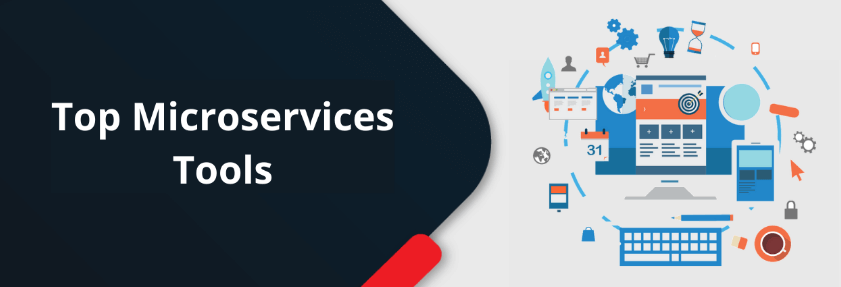Microservices Tools
In this tutorial, we will discuss Top Microservices Tools. Microservices tools are a collection of various tools and technologies having various functionalities.
These tools are used in various stages of building an application and help the developer to work with ease. They come with pre-defined functions, algorithms, and a very user-friendly GUI. Also, several start-ups and tech giants have been working on developing such user-friendly microservices tools. However, since microservices is an architectural style, it is often never enough to use one tool for the entire workflow.
Microservices Tools

1. Operating System
One of the very important factors of building an application is setting a proper foundation for your application. Well, this is done by the operating system. Linux is one such operating system, most commonly used while building applications.
With the help of Linux containers, it provides a self-contained execution environment and lets you orchestrate small to big services like security, networking, and storage. So, if you ask me for better choices from the Linux family, then I feel, Red Hat and Ubuntu are full featuring operating systems with unnecessary functionalities. Apart from these, Linux providers have come up with tools such as Atomic Red Hat and Ubuntu including LXD, which is a container-oriented hypervisor.
2. Programming Languages
The main advantage of microservices is that different languages and technologies can be used to build different services of the same application. So, it gives the developers the freedom to choose their technology stack and build the application. But, the most popular programming languages used in microservices are Spring boot and Elixir.
Spring Boot
Spring Boot simplifies the creation of REST-based microservices with the help of Spring Boot frameworks in just a few lines of code. Here are a few features of Spring Boot:
- Provides auto-configuration to load a set of default configurations for a quick start of the application
- It comes with embedded tomcat, servlet containers jetty to avoid the usage of WAR files
- Spring Boot provides an opinionated view to reduce the developer effort and simplify maven configurations
- Consists a wide range of APIs for monitoring and managing applications in dev and prod.
Elixir
Elixir is a general-purpose programming language that runs on the Erlang virtual machine. Elixir shares the same abstractions for building fault-tolerant and distributed applications.
3. API Management and Testing Tools
While you start building applications using microservices, you also have to make sure that all the individual services communicate with each other using APIs’. Each microservice can have its own API to communicate with the other service. This is where API management and testing come into the picture, as all the APIs present in the system, must be properly managed and tested to get the desired results. The tools used for API Management and Testing are as follows:
4. Messaging Tools
Microservices are a system, where autonomous services, communicate with each other or within themselves. To communicate with each other, microservices use messaging queues. So, the tools used for messaging are as follows:
5. Architectural Frameworks
Since microservices itself is an architectural style, the architectural framework is an important factor. These frameworks are used with various technologies to build applications. The two popular architectural frameworks are as follows:
Goa
This architectural framework provides a way to build REST APIs’ and microservices using Golang. With the help of this architectural framework, you can design APIs along with their required dependencies. This framework runs on top of the Google Cloud Platform. A few of the features are as follows:
- This tool lets you describe the endpoints, global points to make a service API.
- Goa lets you generate the data structures, validation code and handlers once the design of API is set.
- Has a decoupled engine.
- Provides plugins which can implement custom DSLs and also generate arbitrary outputs.
Kong
Microservices Tools – EdurekaKong is used for ready-to-deploy plugins for enhancing the development and deployment of microservices, With this tool, you can leverage the container and microservices design patterns to quickly build API-centric applications. Below are a few features of Kong
- Provides plugins to extend and connect services across hybrid and multi-cloud environments.
- Analyzes real-time data and leverages ecosystems to deploy Kong with Kubernetes
- Kong connects with automation tools to improve efficiency and reduce errors.
- Provides role-based access control and encrypts end-to-end to comply with industry regulations.
6. Tools for Orchestration
As microservices work with respect to containers, container orchestration is an important aspect that needs to be considered. In today’s market, there are various tools regarding the container orchestration for microservices, but the top tools are as follows
Kubernetes
Kubernetes is an open-source container management (orchestration) tool. Its container management responsibilities include container deployment, scaling & descaling of containers & container load balancing. Going by the definition, you might feel Kubernetes is very ordinary and unimportant. But trust me, this world needs Kubernetes for managing containers, as much as it needs Docker for creating them.
Istio
Istio supports service deployment on Kubernetes. It also provides features for manageability, security, and reliability to microservices communications. Well, this is done by the service mesh technology which allows you to improve the relationships and interactions between applications and microservices.
7. Tools for Monitoring
Once the application, is built, it is very important, to monitor the working of applications. So, to monitor applications, you can use the following tools
- Logstash
- Prometheus